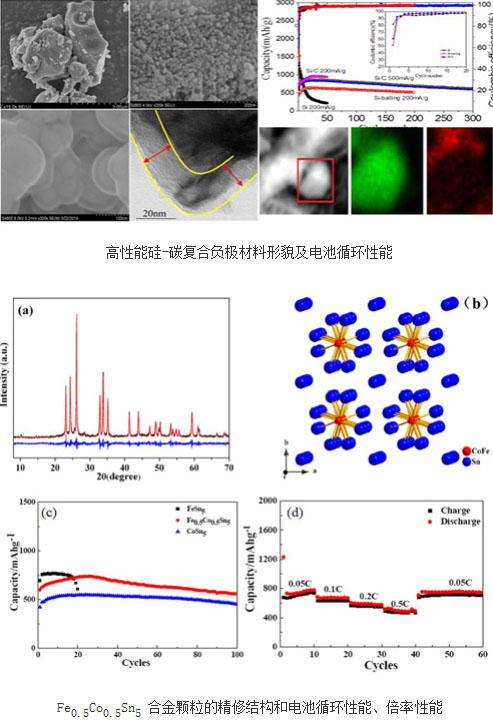Ningbo Materials Co., Ltd. has made series progress in the field of anode materials for high-performance lithium-ion batteries

Compared with lead-acid, nickel-cadmium, nickel-hydrogen and other batteries, lithium-ion batteries have become a hot topic in the field of energy research because of their higher energy density, longer service life, smaller volume, and no memory effect. one. The negative electrode material is one of the key components of the lithium ion battery, which acts as a lithium ion acceptor, and realizes the insertion and extraction of lithium ions during charge and discharge. Therefore, the quality of the negative electrode material directly affects the overall performance of the lithium ion battery. At present, graphite and modified graphite are widely used as cathode materials for commercial lithium ion batteries, but its theoretical capacity is only 372 mAh/g, which greatly restricts the development of high-energy power batteries.
Because of its high theoretical capacity (3579mAh/g, 1600mAh/g, 994mAh/g, respectively), the negative electrode materials of group IV (silicon, antimony, tin) anodes have become a hotspot in the field of anode materials for next-generation lithium-ion batteries. However, silicon, germanium, and tin-based negative electrode materials have a problem of large volume expansion during charging and discharging, and long-term charge and discharge may cause particle pulverization and exfoliation of active materials, thereby affecting the cycling stability of the lithium ion battery.
In recent years, the advanced lithium-ion battery team led by Han Weiqiang, a researcher of the Institute of New Energy Technology under the Ningbo Institute of Materials Technology and Engineering, Chinese Academy of Sciences, has made progress in high-capacity silicon, germanium, and tin-based anode materials. In the field of high-performance silicon-based anode materials, researchers have developed a low-cost, high-capacity, high-stability porous silicon-based anode material technology. Carbon coating of porous silicon further improves the performance of silicon-based anode materials for lithium-ion batteries. After the silicon-carbon composite electrode material was charged and discharged for 300 cycles, the capacity retention rate was 86.8%. Related research has applied for Chinese invention patents (201410150747.5, 201410276413.2), and the results were published in the form of Communication on Nano Energy (2015, 11, 490-499).
On the basis of the previous work, the team used the improved wet-chemical method of polyols to synthesize a series of new phase nanomaterials of MSn5 (M=Fe, Co, Fe0.5Co0.5) alloys. Synthesized FeSn5 alloy nanoparticles, when used as a negative electrode material for lithium ion batteries, have a theoretical capacity of 929 mAhg-1, which is the highest reported theoretical specific capacity of M-Sn (M is an electrochemically inert metal) alloy. Researchers prepared Fe0.5Co0.5Sn5 new phase alloy nanoparticles with a range of particle sizes ranging from 30 to 50 nm. This new phase further extends the Co-Fe-Sn phase diagram. Related results have applied for patents for inventions (2013104705134, 201310706760X, 2103715406A). At the same time, the in-situ XAFS, in-situ XRD and electrochemical testing methods were used to investigate and explain the charge-discharge mechanism. The research on the electrochemical mechanism of this series of tin-based new phase alloy anode materials provides effective theoretical guidance for the team to develop high performance tin-based anode materials. The relevant results were published in Journal of Materials Chemistry A (2015, 3(13):7170-7178) and ACS Appl.Mater.Interfaces (2015, 7, 7912−7919).
The team also made progress in the research and development of long-life titanium-based anode materials and applied for an invention patent (201310685139.X). The relevant results were published in the Journal of Materials Chemistry A (2014(2), 10599-10606).
The above research work was supported by key scientific and technological innovation teams in Zhejiang Province, the 3315 International Innovation Team of Ningbo City, the National Natural Science Foundation of China, the Postdoctoral Science Fund of China, the Postdoctoral Research Project of Zhejiang Province, and the Natural Science Foundation of Ningbo City.
Our Garden Tools use most-effective price to supply best quality in china.Gasoline saw has more proessional quality than market.
Garden Tools
Gasoline Lawn Mower, Gasoline Trimmer, Gasoline Tools, Petrol Tools
YongKang WALMA Tools CO., LTD. , http://www.walmatools.com